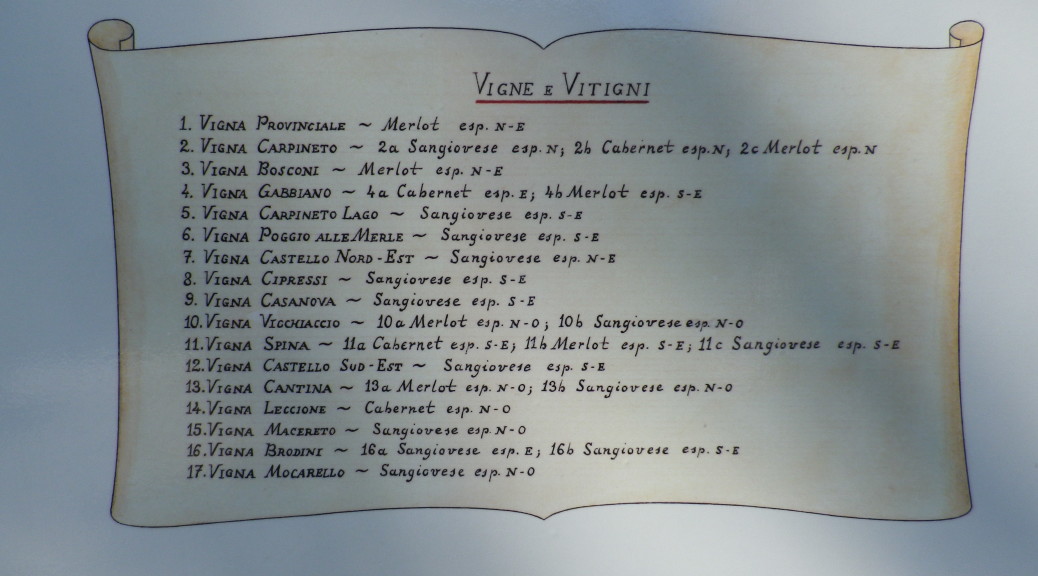What I Learned (Production: Style and Methods)
Chianti wine comes from the wine region of Chianti, south of Florence, in Tuscany. Chianti wine has been well-known for centuries. Nonetheless, it wasn’t until 1996 that the wine district of Chianti Classico was created. The current district boundary most closely approximates the geographic limits of Chianti wines identified by the Grand Duke of Tuscany in 1716. All modern day wines bearing the words “Chianti Classico”, must come from this designated area. (Look for the Black Rooster!)
Among the Chianti Classico wines, there is a wide variety to choose from. In addition to the quality levels mentioned below, customers find labels bearing the words Chianti Classico, Chianti Classico Riserva, Chianti Classico Superiore and Chianti Classico Gran Selezione.
One example, albeit highly simplified, should suffice to demonstrate some of the differences in the law that enable vintners to label their products in the various ways identified above. After harvesting grapes grown in the Chianti Classico designated area, a vintner takes a minimum of 80 percent of the juice from Sangiovese grapes, and combines them with juice from Canaiolo or Colorino, or some other red grape (often Merlot) permitted to be blended with Sangiovese to make Chianti Classico wine. This wine must age for a minimum of one year and have a minimum of 12 percent alcohol before it may be sold as Chianti Classico. If that same wine, rather than being bottled, is aged further in small oak casks for a minimum period of months, followed by an additional 3 months refining in the bottle, it may then be sold as Chianti Classico Riserva, as long as the wine has a minimum of 12.5 percent alcohol. If the blend comes from grapes that are selected from only the proprietor’s vineyards, it has aged at least 30 months, and it has a minimum of 13 percent alcohol, the wine may be sold as Chianti Classico Gran Selezione. Many other rules, such as yield per hectare, size and composition of the casks, et cetera, come into play as well, but this gives a general idea of some of the differences between a Chianti Classico, Chianti Classico Riserva, and a Chianti Classico Gran Selezione.
In 1967, Chianti wines attained the right to bear the DOC (Denominazione di Origine Controllata) level of quality. It wasn’t until 1984 that Chianti wines could bear the DOCG (Denominazione di Origine Controllata e Garantita) quality label.
Meanwhile, vintners began to innovate. Different varietals, different mixtures of varietals, different production methods produced new and exciting wines. And throughout it all, the focus was on quality. These wines, identified with another designation promoted by new laws, the IGT (Indicazione Geografica Tipica), made their appearance in the marketplace. The IGT designated wines represent estate bottlings of estate-grown grapes, which are not the traditional Chiantis, as established by law, but rather new efforts on the part of dedicated vintners to introduce wines that help reflect the character of the grapes, wine-maker’s skill, and a passion and pride for wine-making.
Now, wine-lovers can find bottles labelled Chianti, Chianti Classico, Chianti Classico Riserva, Chianti Classico Superiore, Chianti Classico Gran Selezione, DOC, DOCG and IGT, depending on the established viticultural and vinicultural practices employed to produce that particular bottle of wine. In summary, the wines from the Chianti Classico district are much improved, and the demand for wines from this area has increased.
The wines below came from the area around Greve, in the northern part of the Chianti Classico zone.
What I Tasted
2014 Rose, IGT Rosato Toscana, Castello di Gabbiano: A dry rose wine (90% Sangiovese, 10% Merlot) with light salmon color; Nose has vegetal notes, and smoky, berry flavors; Extremely mild tannins, a slight prickling on the tongue, and a long finish – interesting to drink.
2013 Ripa delle Mandorle, IGT Toscana, Castel Vicchiomaggio: A dry red wine (75 percent Sangiovese and 25 percent Cabernet Sauvignon) with medium ruby-red color; Hints of smoke on the nose, and cherry and smoke flavors; Very mild tannins and mildly acidic.
2012 Chianti Classico Riserva, DOCG, Castello di Gabbiano: A dry red wine (95% Sangiovese, 5 % Merlot) with medium ruby-red color; Slightly spicy nose, and red fruits and spice flavors; Medium tannins.
2012 Chianti Classico, DOCG, Castello di Gabbiano: A dry red wine with medium ruby-red color; Fruity nose, and cherry and plum flavors; Mild tannins.
2011 Ripa delle More, IGT Toscana, Castel Vicchiomaggio: A dry red wine (50 percent Sangiovese, 30 percent Cabernet Sauvignon, 20 percent Merlot) and very dark red color; Nose of cherry and oak, with cherry and oak flavors; Medium tannins.
2011 Chianti Classico, DOCG, Bellezza, Gran Selezione, Castello di Gabbiano: A dry red wine (100% Sangiovese) with dark red color; Nose is fruity, red berry, vanilla and mild oak flavors; Medium tannins.
2011 Alleanza, IGT Rosso Toscana, Castello di Gabbiano: A dry red wine (Merlot and Cabernet Sauvignon Blend) with very dark red color; Nose has vegetal notes, and ripe red fruit and oak flavors; Mild tannins.
